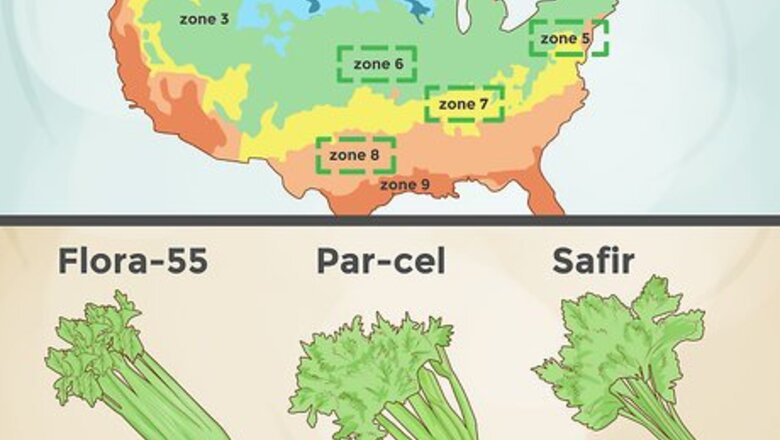
views
Choosing a Variety
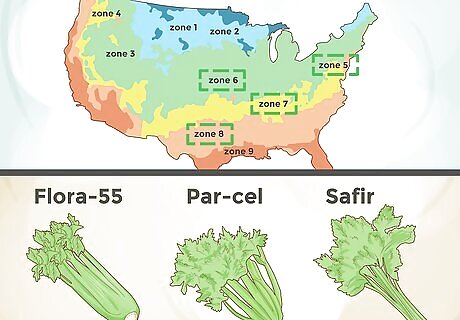
Grow leaf celery in USDA hardiness zones 5a through 8b. Leaf celery (Apium graveolens var. secalinum) grows from a strong stalk and produces delicious leaves that are more flavorful than the leaves of other varieties. While there are several varieties of leaf celery to choose from, a few popular varieties include Par-Cel, a Dutch heirloom variety, Safir, which has a spicy crunch to it, and Flora-55, which is best at resisting bolting (flowering).
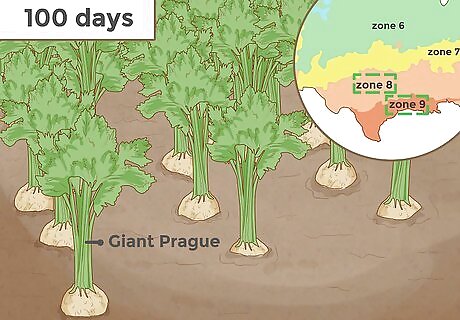
Grow celeriac in USDA plant hardiness zones 8 and 9. Celeriac (Apium graveolens var. rapaceum) grows an oversized root that can be harvested and eaten in addition to the stalks. A root takes about 100 days to grow large enough to be harvested and cooked. Celeriac, which likes especially cool coastal climate conditions, comes in several varieties including Brilliant, Giant Prague, Mentor, President and Diamant.
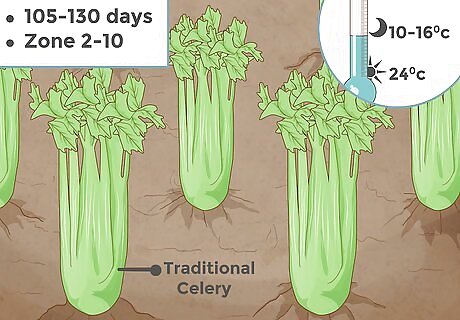
Grow traditional celery in USDA plant hardiness zones 2 through 10. Traditional celery (Apium graveolens var. dulce) requires long, temperate growing seasons and takes about 105 to 130 days to mature enough for harvest. It does not like extreme temperatures and grows best with conditions under 75 °F (24 °C) during the day and between 50 and 60° Fahrenheit (10-16° C) at night. Some varieties include Conquistador and Monterey, which are ready for harvest earlier than most varieties, Golden Boy, which produces stunted stalks, and Tall Utah, which produces tall, vibrant stalks.
Prepping Your Garden
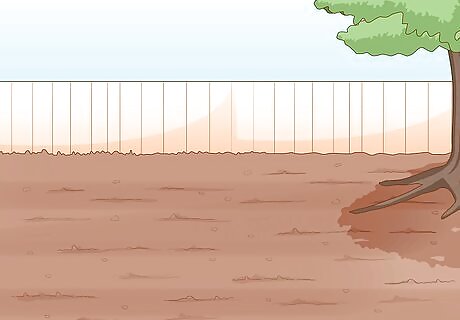
Choose an area with full sun and/or partial shade. While preferring a temperate climate, celery also enjoys full sun if possible. However, it will grow well in partial shade as well.

Choose an area with rich, moist soil. Originally a wetland plant, celery can tolerate relatively moist soil conditions that other vegetables cannot. However, make sure the planting area you choose is not prone to flooding. You may want to build a raised bed to plant your celery in. Keep in mind that some varieties of celery grow very large, harvestable roots, so make sure to build your planter deep enough if you choose to do so. Use cedar wood to build the planter bed if possible, as it does not mold when it gets wet.
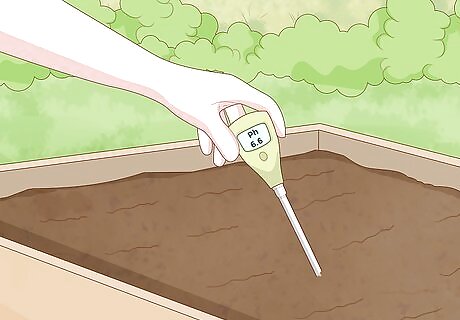
Test the pH of the soil. Celery varieties prefer slightly acidic soil with a pH between 6.0 and 7.0. Though celery does not require impeccable drainage like most vegetables, it does require rich, healthy soil. Evaluate the soil's calcium and magnesium levels in order to determine what type of limestone to add to your soil. If the soil is low in magnesium, add dolomitic limestone. If it is high in magnesium, add calcitic limestone. Add the limestone 2 to 3 months before planting if possible to allow the soil to absorb it. After adding, check the pH again.

Fertilize the soil with a high-nitrogen organic fertilizer. Mix about 4 inches (10 cm) of organic fertilizer, such as manure or compost, into your soil. Celery likes extremely rich, organic soil. This will help the seedlings grow into strong, producing plants.
Planting the Celery
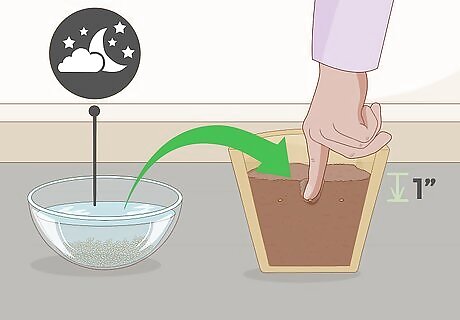
Start your celery seeds indoors 10-12 weeks before the last spring frost. You can sow the seeds in peat pots with several seeds per cell to ensure that at least 1 will germinate into a seedling. To speed up germination, you can pre-soak your seeds in water overnight. Cover with about 1 inch (2.5 cm) of potting soil, but do not pat down with your fingers after sowing the seeds. Celery seeds need a lot of light to germinate. Water the peat pots to moisten the soil after planting your seeds. Place your seeds in a warm place so that the soil stays between 70 and 75° Fahrenheit (21-24° Celsius) until the seeds germinate. This should take 2 to 3 weeks. After germination, place the seedlings in a cooler indoor location so that the soil is between 60 and 70° Fahrenheit (16-21° Celsius). Carefully thin the seedlings so that there is only 1 per cell after they germinate.
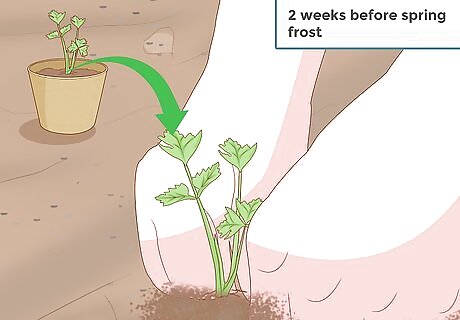
Transfer seedlings to the garden 2 weeks before the last spring frost. Make sure that it is not too cold outside. Celery can handle a light frost, but temperatures below 55 °F (13 °C) in the day and 40 °F (4 °C) at night for longer than 1 week can harm your celery plants.
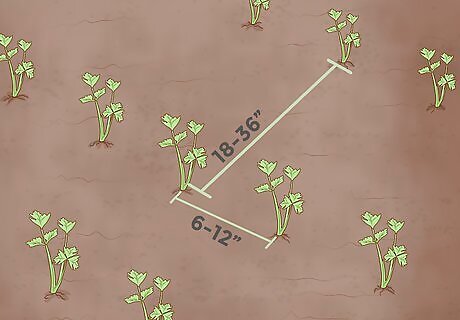
Give the seedlings plenty of space. Plant the seedlings 6 to 12 inches (15.2 to 30.5 cm) apart in rows 18 to 36 inches (45.7 to 91.4 cm) apart. You only need to dig holes slightly deeper than the depth of the peat pots cells. Pat the sides of the cells to get the seedlings to slip out without harming the roots.
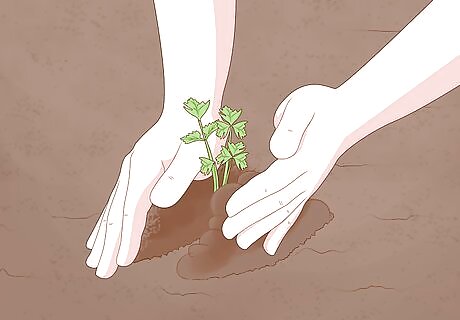
Place the seedlings in the ground and cover with soil. Only cover up to the first level of foliage and pat the planting area around the seedlings lightly with your hands for support.

Water the planting area very thoroughly. Celery requires constant moisture, so do not allow the soil to dry out at any time. If celery does not get enough water, the stalks will be stringy and bitter. Be sure to water several times per week and increase your watering routine during particularly warm or dry spells.

Add mulch to the planting area. To keep the soil cool and moist, add a few inches or centimeters of mulch made of leaves, grass, hay, or other plant material on top of the soil. Doing so also helps reduce the ability of weeds to infiltrate the planting area.
Caring for Your Celery Plants
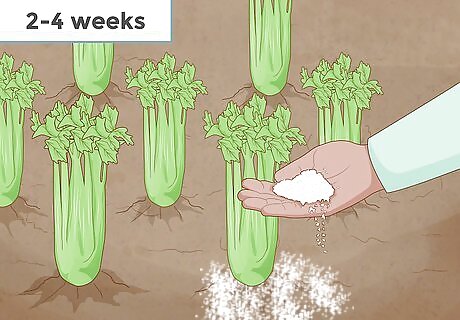
Fertilize every 2 to 4 weeks. Celery plants are heavy feeders that require rich soil that must be fertilized frequently. To keep your celery plants happy, fertilize with a nitrogen-rich fertilizer every few weeks from planting to harvest.
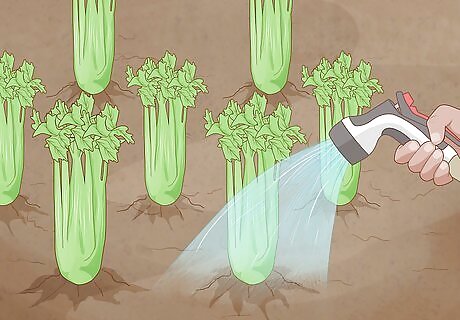
Water your plants regularly. The most important aspect of caring for your celery plants is making sure that they are always well-hydrated. If they do not get enough water, celery plants will become shriveled and bitter to the taste.
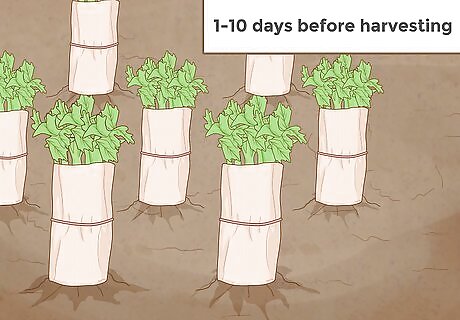
Blanch celery 1 week to 10 days before harvesting, if desired. Blanching consists of shielding the celery stalks from the sun to achieve a milder flavor. Cover the stalks with newspaper, a milk carton with the top and bottom removed, or any other type of paper or cardboard. You can use twine to tie the celery stalks to keep them from sprawling. While blanching is not required, it will alter the taste and color of your celery. Additionally, blanched celery is less nutritious than unblanched celery. Most people prefer the sweeter taste of blanched celery. Be aware that some varieties are "self-blanching" and don't need to be blanched.
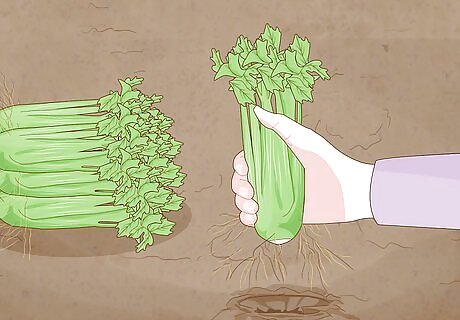
Harvest the celery stalks, leaves, and/or roots. You can begin to harvest the stalks when they reach 8 inches (20 cm) in height. Make sure to begin your harvest from the outside stalks and work inward. This allows the innermost stalks to continue to mature. Once mature, celery can sit in the ground for about 1 month as long as the soil remains a cool temperature between 60° and 75° Fahrenheit (16-24° Celsius). The longer the celery grows and the darker it becomes, the richer in antioxidants and more nutritious it will be. However, it will also become more tough and fibrous.




















Comments
0 comment